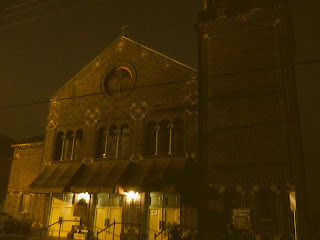
St. Henry's Church
812 General Pershing St.
New Orleans, La.
Dear Family and Friends,
The 24-7 occupation of a local church has lasted longer than expected, on the backs of women in wheelchairs, retired couples, and on long-time parishioners who used to only see St. Henry's on Sunday.
It's a quiet place most hours now, where air mattresses are laid out for overnight vigil shifts and Christmas lights go on at dark. One vigiler leaves donuts for the people who relieve her. There is a mini-fridge, like the ones in Tulane dorm rooms about a mile away.
St. Henry's is 157, but the archdiocese of New Orleans closed it two months ago, citing a lack of priests parish-wide. After the final mass, when St. Henry's priest asked everyone to abide by the archdiocese's wishes, two parishoners refused to leave.
St. Henry's new existence, an around the clock vigil, enters hour 1, 500 on New Year's eve.
Leaders of the movement began a newsletter along with the vigil campaign. Their letterhead reads, St. Henry's: "Established by New Orleans Catholics in 1851 and Suppressed by the New Orleans Archdiocese in 2008."
When one month became two, parishoners silently congratulated their successes--spreadsheet schedules, breakfast duties and even a vigil cell phone left near the alter at all times. But, as these families are hoping for a victory--a sanctioned reopening of their parish--they are simultaneously preparing for a long and unglamorous task.
In Boston, one parish is staging a 24-hour vigil that will enter its fifth year in 2009.
"We'll be here as long as it takes to get our church back, vigiler Donna Williams says. "They can even turn the lights out on us."
Currently, all electricity works at St. Henry's because an adjacent building the parish owns is being rented, Donna says.
 Vigilers say that even if the power is shut off, their occupation will not stop. Most shifts last four hours, but the overnight shift lasts eight.
Vigilers say that even if the power is shut off, their occupation will not stop. Most shifts last four hours, but the overnight shift lasts eight.St. Henry is financially stable and had little flood damage in Hurricane Katrina according to parishoners. The archdiocese cites declining Priest roles as the reason for the closing.
“The driving factor is that there are fewer and fewer vocations,” archdiocese spokeswoman Sarah Comiskey told The Associated Press. “There are a declining number of priests and we have to be responsible as to how we assign them.”
The Louisiana Weekly says a total of 33 parishes have been closed to date. Among those, six churches have been converted to other uses. The three closed Oct. 26 — St. Henry, Our Lady of Good Counsel and St. Francis de Sales — are the last to be shut down, Comiskey said.
Parishoners have filed an initial appeal in Rome and recently found out that it was denied.
In a decidedly Catholic city, the parish closings have been lumped in with other post-Katrina tear-jerking scenarios. Tragedy piles are high, and the heaps continue their growth three years after the storm. Churches closed. Schools closed. Hospitals closed.
St. Henry's demise is head-scratching because parishoners claim financial stability, a physically sound building and a Priest who has been its leader for 19 years.
A statue of St. Joseph flanked my air mattress during my overnight vigil. I only decided to sleep in a church because it was a mini-adventure. I now realize though, people love their buildings. Especially in New Orleans, where so many were lost, keeping the ones we have means very much.

The buildings where people say, "I was born there" or "That was my school" are even more important to the health of a community. They keep the City's memories and host the new ones.
The final archdiocese-recognized activity at St. Henry's happened in November.
It was a wedding.
Best,
Robert


